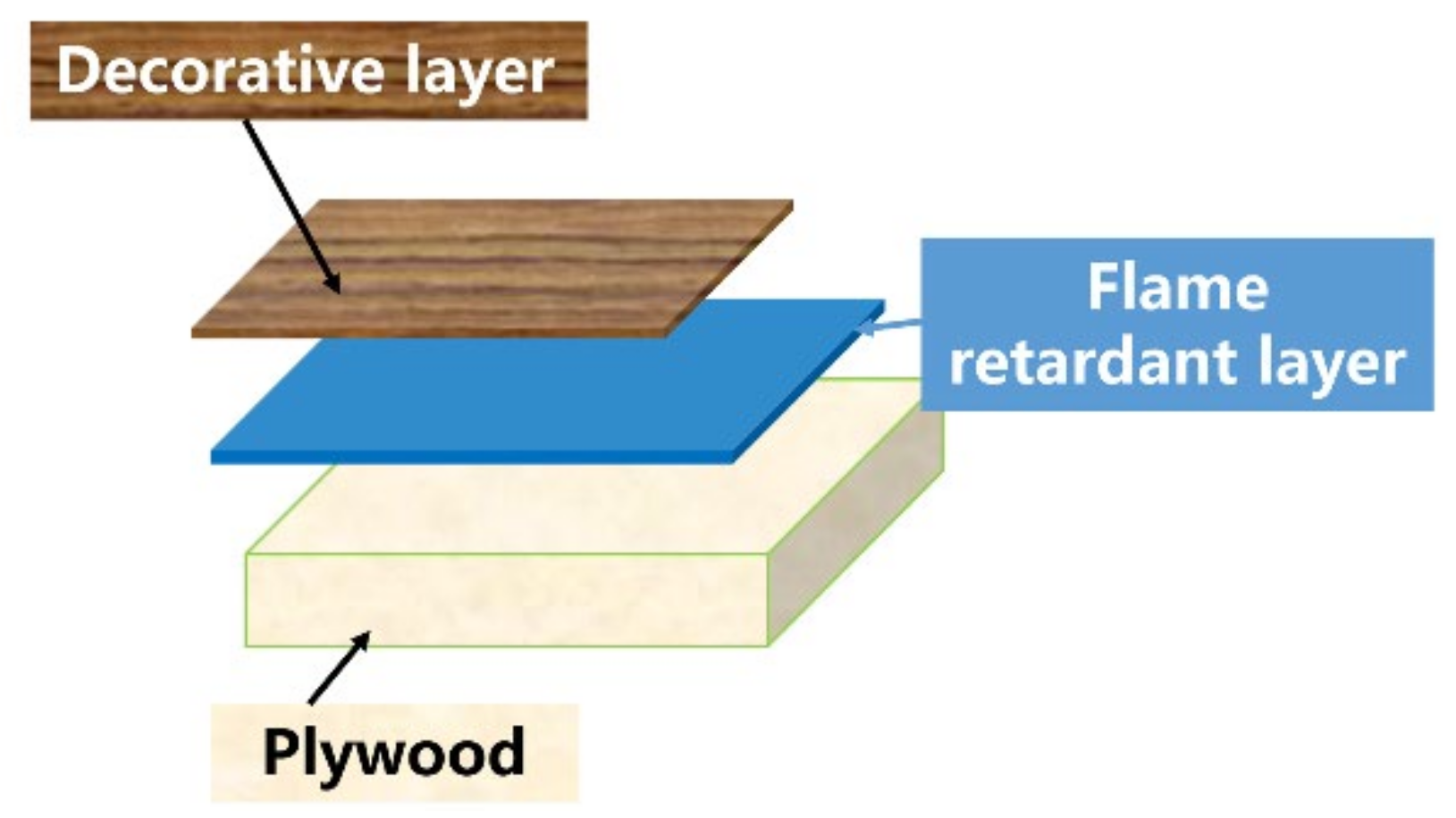2.1. Materials
Ammonium polyphosphate (APP, n > 1000, Mn > 208,000) was purchased from Sichuan Changfeng Chemical Co., Ltd. (Deyang, China). Pentaerythritol (PER), melamine, urea and formaldehyde solution (37–40%) were purchased from Beijing Modern Eastern Fine Chemical Co., Ltd. (Beijing, China). Sodium hydroxide (NaOH) was acquired from Sinopharm Chemical Reagent Co., Ltd. (Shanghai, China). Decorative veneers and plywood were supplied by Shijiazhuang Huajie Wood Co., Ltd. (Shijiazhuang, China). All materials were used as received.
2.2. Sample Preparation
MUF resin was prepared with formaldehyde, melamine and urea [
14]. First, 120 g of formaldehyde solution (37%) and 40 g of urea were mixed in a reactor equipped with thermometer and mechanical stirrer, and the pH was adjusted to 8.0–9.0 with 1 M NaOH. The mixture was heated to 90 °C for 35 min. Then the pH was adjusted to 5.0–5.5 with NH4Cl, followed by the addition of 15 g of urea and 10 g of melamine for 40 min with the pH = 8.5. MUF resin was successfully synthesized and cooled down. The molar ratio of formaldehyde to urea and melamine, F/(M+U), was 1.3. The flame retardant adhesive was prepared by mixing the APP, PER and MUF, which were then fully stirred by the rotary agitator. The formulations of the intumescent flame retardant adhesive are listed in
Table 1.
The structure of the FRD-plywood is shown in
Figure 1. The flame retardant layer was established between the decorative layer and the substrate. The flame retardant layer was composed of APP, PER and MUF. The decorated plywood was prepared through two steps. Firstly, the flame retardant adhesive resin was coated on the surface of poplar plywood (300 mm × 300 mm × 9 mm). Secondly, a piece of decorative veneer (310 mm × 310 mm × 0.5 mm) was hot-pressed on the top of the coated plywood with 8 MPa and at 110 °C, and was maintained for 5 min. The specimen for CONE was cut into 100 mm × 100 mm pieces. FRD-plywood (a big scale sample for SBI) was prepared using A3P1 adhesive and plywood (1220 mm × 2440 mm × 18 mm).
The flame retardant steel boards (for back temperature tests) were prepared by coating the resin on the steel boards (100 mm × 100 mm × 2 mm). The char samples of the flame retardant adhesive were prepared in muffle furnace for 30 s at 800 °C.
2.3. Measurements and Characterization
The wet shear strength of plywood samples was measured in accordance with the Chinese National Standard (GB/T17657-1999). Twelve plywood specimens (2.5 cm × 10 cm) cut from two plywood panels were submerged in water at 63 ± 2 °C for 3 h, and then dried at room temperature for 10 min before tension testing. The bonding strength was calculated using following equation:
Thermogravimetric analysis (TG) was performed by using a SDT Q600 thermal analyzer (TA Instruments, New Castle, DE, USA). The sample with a 3 mg weight was placed in an alumina crucible and at a heating rate of 10 °C /min under an N2 atmosphere from 30 to 800 °C.
Char volume was measured by paraffin embedding to reinforce the char structure and insulate the water. The char morphology was monitored by using a digital camera (Sony, Tokyo, Japan).
The micromorphology images of char were analyzed by using scanning electron microscopy (SEM, S4800, Hitachi, Tokyo, Japan) at high vacuum conditions with a voltage of 10 kV. Prior to observation, all samples were gold-sputtered to improve their conductivity.
Fourier transform infrared spectra (FTIR) of resin and its char were recorded by using Nicolet Is50 (Thermofisher, Waltham, MA, USA) from 400 to 4000 cm−1. The differentiation rate was 4 cm−1 and the number of scans was 8.
Laser Raman spectroscopy (LRS) was carried out on a micro Raman imaging spectrometer (DXRxi, Thermofisher, Waltham, MA, USA) with a 532 nm helium-neon laser line. The laser beam focused on the surface to scan in the 50-3400 cm−1 region.
Cone Calorimeter (FTT UK, Derby, UK) was used to evaluate the flammability of plywood based on ISO 5660-1 [
22] under an external heat flux of 50 kW/m
2. Three replicates were tested were calculated for each plywood type. The Back temperature was measured by using thermocouples (Testo 176 T4, Testo, Lenzkirch, Germany) laid on the bottom of steel board test under CONE from 0 to 700 s under the external heat flux of 50 kW/m
2.
Single burning item (SBI, Motis, Kunshan, China) was used to evaluate the combustion results of plywood according to the China National Standard (GB/T 20284 and GB/T 8626) from 0 s to 1300 s. The same method was used to classify most building products in Europe (EN 13823). The specimen was mounted on a trolley that is positioned in a frame beneath an exhaust system. The reaction of the specimen to the burner was monitored instrumentally and visually. Heat and smoke release rates were measured instrumentally and physical characteristics were assessed through observation. According to GB/T 8624, the building products were assessed into classes A1, A2, B1, B2, and B3, which are different from the classes A-F in Europe. For example, the classes B and C in the European criteria belong to class B1 in GB/T 8624, and were written as B1(B) and B1(C), respectively. The test results were required for a classification A2 (combined with the test results from GB/T 5464 and GB/T 14402), B1and B2 (combined with test results from GB/T 8626). These were given in
Table 2. FIGRA is an indication of fire growth rate based on heat release. LFS indicates whether the spreading of a lateral flame to the end of the long wing was observed or not.














